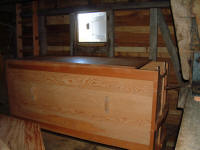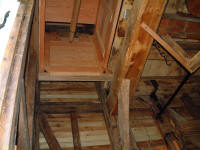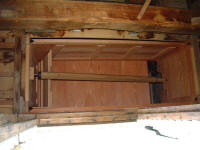
|
|
||||

|
|
||||

|
|
||||
19th March 2007 - Bolter progress
The bolter has now been installed in the mill after some manoeuvring involving enlargement of the hole! The hopper frame has been built; this was very difficult due to the angles involved and the cramped access. In the end though it is a good fit, but we have not installed it yet as we are currently working on the rear bearing mount frame, which would be impossible with the hopper in position. As can be seen in the photo, the shaft has been temporarily installed; this will enable us to position the rear bearing. Part of the rear bearing frame is an original piece which will be the only original part; it was luckily still in situ even though the remainder of the bolter had disappeared.
|
|
||||
|
|
||||
|
|
|||||
23rd July 2006 - Bolter progress
We have almost finished manufacture of the main feed hopper, which just needs the entry hatch cut out. The hopper has been moved temporarily to the spout floor as we are struggling with room in the roundhouse.
The main bolter shaft is now nearing completion so we have turned our attention to the fitting of the bolter in the rear of the stone floor. The old floor, which was actually only installed in the 1960's has been removed and a start made on working out how the bolter can safely be bolted within the floor void.
26th February 2006 - Bolter progress back to top of page
The bolter is basically a rotating sieve for grading the flour and is the last part of the restoration of the windmill. Although the original bolter was missing, by some good fortune we still have the remains of the central oak shaft plus a photograph taken in 1955 of the remains in situ, although I have to say that there was not much there! I knew of a bolter in Keston windmill near Bromley and a visit confirmed that it was almost identical in size and best of all the shaft was exactly the same size. So after several visits to measure the Keston bolter in detail the work began in November 2003 and is continuing after the production so far of 55 working drawings.
|
|
|
|
|
|